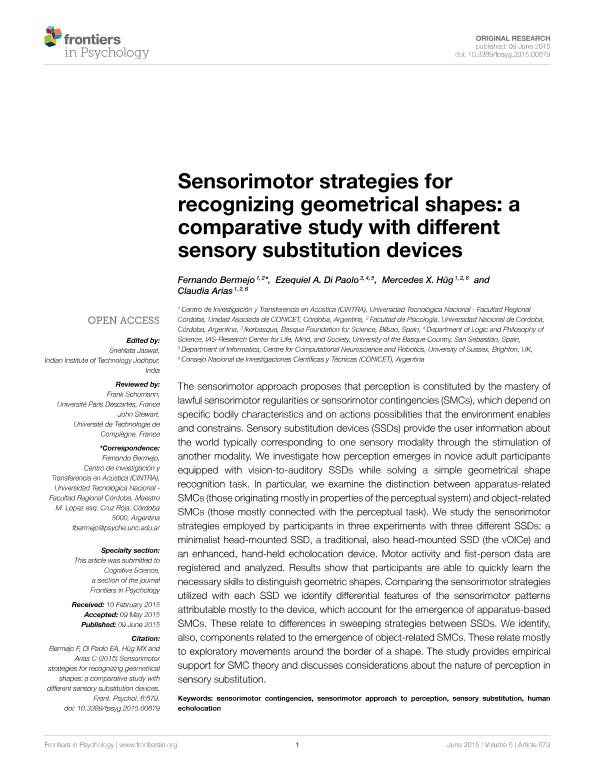Mostrar el registro sencillo del ítem
dc.contributor.author
Bermejo, Fernando Raul

dc.contributor.author
Di Paolo, Ezequiel Alejandro

dc.contributor.author
Hüg, Mercedes X.
dc.contributor.author
Arias, Claudia

dc.date.available
2019-02-05T14:56:56Z
dc.date.issued
2015-06
dc.identifier.citation
Bermejo, Fernando Raul; Di Paolo, Ezequiel Alejandro; Hüg, Mercedes X.; Arias, Claudia; Sensorimotor strategies for recognizing geometrical shapes: A comparative study with different sensory substitution devices; Frontiers Media S.A.; Frontiers in Psychology; 6; MAY; 6-2015; 1-20
dc.identifier.issn
1664-1078
dc.identifier.uri
http://hdl.handle.net/11336/69396
dc.description.abstract
The sensorimotor approach proposes that perception is constituted by the mastery of lawful sensorimotor regularities or sensorimotor contingencies (SMCs), which depend on specific bodily characteristics and on actions possibilities that the environment enables and constrains. Sensory substitution devices (SSDs) provide the user information about the world typically corresponding to one sensory modality through the stimulation of another modality. We investigate how perception emerges in novice adult participants equipped with vision-to-auditory SSDs while solving a simple geometrical shape recognition task. In particular, we examine the distinction between apparatus-related SMCs (those originating mostly in properties of the perceptual system) and object-related SMCs (those mostly connected with the perceptual task). We study the sensorimotor strategies employed by participants in three experiments with three different SSDs: a minimalist head-mounted SSD, a traditional, also head-mounted SSD (the vOICe) and an enhanced, hand-held echolocation device. Motor activity and fist- person data are registered and analyzed. Results show that participants are able to quickly learn the necessary skills to distinguish geometric shapes. Comparing the sensorimotor strategies utilized with each SSD we identify differential features of the sensorimotor patterns attributable mostly to the device, which account for the emergence of apparatus-based SMCs. These relate to differences in sweeping strategies between SSDs. We identify, also, components related to the emergence of object-related SMCs. These relate mostly to exploratory movements around the border of a shape. The study provides empirical support for SMC theory and discusses considerations about the nature of perception in sensory substitution.
dc.format
application/pdf
dc.language.iso
eng
dc.publisher
Frontiers Media S.A.
dc.rights
info:eu-repo/semantics/openAccess
dc.rights.uri
https://creativecommons.org/licenses/by-nc-sa/2.5/ar/
dc.subject
Human Echolocation
dc.subject
Sensorimotor Approach to Perception
dc.subject
Sensorimotor Contingencies
dc.subject
Sensory Substitution
dc.subject.classification
Psicología

dc.subject.classification
Psicología

dc.subject.classification
CIENCIAS SOCIALES

dc.title
Sensorimotor strategies for recognizing geometrical shapes: A comparative study with different sensory substitution devices
dc.type
info:eu-repo/semantics/article
dc.type
info:ar-repo/semantics/artículo
dc.type
info:eu-repo/semantics/publishedVersion
dc.date.updated
2019-02-04T13:02:28Z
dc.journal.volume
6
dc.journal.number
MAY
dc.journal.pagination
1-20
dc.journal.pais
Suiza

dc.journal.ciudad
Lausanne
dc.description.fil
Fil: Bermejo, Fernando Raul. Consejo Nacional de Investigaciones Científicas y Técnicas. Centro Científico Tecnológico Conicet - Córdoba; Argentina. Universidad Tecnológica Nacional. Facultad Regional Córdoba. Centro de Investigación y Transferencia en Acústica; Argentina. Universidad Nacional de Córdoba. Facultad de Psicología; Argentina
dc.description.fil
Fil: Di Paolo, Ezequiel Alejandro. Basque Foundation for Science; España. Universidad del País Vasco; España. University of Sussex; Reino Unido
dc.description.fil
Fil: Hüg, Mercedes X.. Consejo Nacional de Investigaciones Científicas y Técnicas; Argentina. Universidad Nacional de Córdoba. Facultad de Psicología; Argentina. Universidad Tecnológica Nacional. Facultad Regional Córdoba. Centro de Investigación y Transferencia en Acústica; Argentina
dc.description.fil
Fil: Arias, Claudia. Consejo Nacional de Investigaciones Científicas y Técnicas; Argentina. Universidad Nacional de Córdoba. Facultad de Psicología; Argentina. Universidad Tecnológica Nacional. Facultad Regional Córdoba. Centro de Investigación y Transferencia en Acústica; Argentina
dc.journal.title
Frontiers in Psychology
dc.relation.alternativeid
info:eu-repo/semantics/altIdentifier/doi/https://dx.doi.org/10.3389/fpsyg.2015.00679
dc.relation.alternativeid
info:eu-repo/semantics/altIdentifier/url/https://www.frontiersin.org/articles/10.3389/fpsyg.2015.00679/full
Archivos asociados
